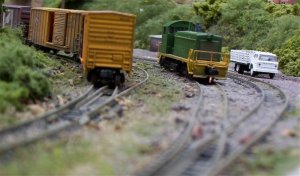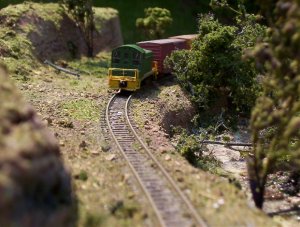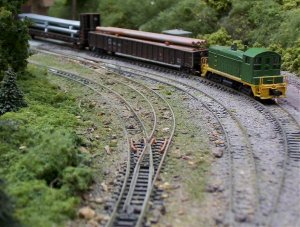I got rejected from Model Railroader
- Thread starter csxengineer
- Start date
You are using an out of date browser. It may not display this or other websites correctly.
You should upgrade or use an alternative browser.
You should upgrade or use an alternative browser.
RonP
Member of the WMRC
Don't worry, we really like them. Who cares about elitist snobs anyways.
Oh! Yeah! :thumb::thumb::thumb::thumb::thumb:
Thanks for sharing your photos.
Glad you showed them to us where they'll be published immediately and you'll get some feedback about how much we like 'em!
Ralph
Ralph
Those are better looking than some of the stuff they do publish.
Some people just have no taste...
Some people just have no taste...
CSX - As someone who has had a number of photos published in MR and RMC over the years, let me offer some tips regarding your photos.
First off, the publishers like shots that include (and have identified) a number of hobby products (vehicles, structures, unusual locomotives). Always list the maker of the items shown, including the source(s) of scenery items.
Second - virtually all portions of the image MUST be in sharp focus, unless you are going for some particular effect. If you have editing software, crop out any soft-looking portions of the image. ALWAYS shoot all your shots at maximum resolution and the absolute maximum f-stop possible with your camera (I typically shoot at between f/27 and f/35). Avoid any Macro settings.
Third - depict something specific and interesting going on, or shoot a rather spectacular/unusual scene - i.e. looking up at a train crossing a trestle, river, highline, etc. Mundane shots don't make the cut.
Fourth - try to get in closer to the action while keeping everything in focus. Perspectives as if seen through the eyes of an 1/87 bystander are attention getters, as sometimes are shots as if looking down from an overpass or building (roundhouse, tower, etc.) at the top of an approaching/passing train. Avoid "helicopter" shots.
Finally, and perhaps most importantly, have the image tell some kind of story, especially one that includes some excellent human figures going about their work. Then too, carefully read over Kalmbach's guidelines for submitting photos for publication - repeatedly! And it is also a good practice to carefully look over the photos that have been published over the last year, so as to gain a feel for the "style" of photo MR is looking for. In 15 years of submitting photos to them, I've only ever had one image rejected.
CNJ999
First off, the publishers like shots that include (and have identified) a number of hobby products (vehicles, structures, unusual locomotives). Always list the maker of the items shown, including the source(s) of scenery items.
Second - virtually all portions of the image MUST be in sharp focus, unless you are going for some particular effect. If you have editing software, crop out any soft-looking portions of the image. ALWAYS shoot all your shots at maximum resolution and the absolute maximum f-stop possible with your camera (I typically shoot at between f/27 and f/35). Avoid any Macro settings.
Third - depict something specific and interesting going on, or shoot a rather spectacular/unusual scene - i.e. looking up at a train crossing a trestle, river, highline, etc. Mundane shots don't make the cut.
Fourth - try to get in closer to the action while keeping everything in focus. Perspectives as if seen through the eyes of an 1/87 bystander are attention getters, as sometimes are shots as if looking down from an overpass or building (roundhouse, tower, etc.) at the top of an approaching/passing train. Avoid "helicopter" shots.
Finally, and perhaps most importantly, have the image tell some kind of story, especially one that includes some excellent human figures going about their work. Then too, carefully read over Kalmbach's guidelines for submitting photos for publication - repeatedly! And it is also a good practice to carefully look over the photos that have been published over the last year, so as to gain a feel for the "style" of photo MR is looking for. In 15 years of submitting photos to them, I've only ever had one image rejected.
CNJ999
thanks
Yeah. I agree with what you said..
There are no people present in my scenes.
I took with a Kodak Easy share digital camera (bargain type)
I did include modelling notes & story..mostly woodland scenics terrain, lifelike engine, etc
thanks for advice.:thumb:
Yeah. I agree with what you said..
There are no people present in my scenes.
I took with a Kodak Easy share digital camera (bargain type)
I did include modelling notes & story..mostly woodland scenics terrain, lifelike engine, etc
thanks for advice.:thumb:
CNJ999,
That is excellent advice and something that we could all use to make even our own pics more interesting regardless if they get published.
Thanks!
That is excellent advice and something that we could all use to make even our own pics more interesting regardless if they get published.
Thanks!
Those are not photos, but I can see they're not quite magazine material.
-Focus
-Level
-Centered
I've learned these lessons the hard way submitting proto photos to RailPictures.net
-Focus
-Level
-Centered
I've learned these lessons the hard way submitting proto photos to RailPictures.net
I'm using a Kodak point and shoot and I don't have the ability to change the F stop. With that said, would it accomplish the same thing by zooming back far enough that all is in focus? Can you elaborate on why to avoid Macro settings?Second - ...ALWAYS shoot all your shots at maximum resolution and the absolute maximum f-stop possible with your camera (I typically shoot at between f/27 and f/35). Avoid any Macro settings.
Can you offer enlightenment on how to do that... getting in close while keeping everything in focus? It seems the closer I get, the more seperation I get.Fourth - try to get in closer to the action while keeping everything in focus.
N
nachoman
if you ever get the chance to check a MR issue from the 50s or 60s, take special note of the trackside photos. The hobby, and photography, has come a long way.
Kevin
Kevin
I'm using a Kodak point and shoot and I don't have the ability to change the F stop. With that said, would it accomplish the same thing by zooming back far enough that all is in focus? Can you elaborate on why to avoid Macro settings?
Can you offer enlightenment on how to do that... getting in close while keeping everything in focus? It seems the closer I get, the more seperation I get.
Well...odds are that any point-and-shoot camera probably won't be capable of producing a publishable image. Until recently I believe that MR wanted a minimum of 5 or 7 megapixels for any submitted digital image. However, they don't seem to list any particular limits currently.
Increasing the distance beteween the camera and the subject, while at the same time switching to a telephoto setting, will normally result in more of the scene being in-focus...provided that the scene itself is not particularly deep to begin with. Zooming in has its own set of disadvantages, however, creating an image distortion generally referred to as "looming". This is where the scene appears compressed and objects in the background appear larger/closer than they really are.
Getting in close while keeping everything in focus can be accomplished by either (A) increasing your f-ratio...something that can't be manually controlled on most inexpensive cameras or (B) reducing the focal length of your lens, i.e. going to a WA setting. The minimum acceptable setting for really close-up images that will also retain some reasonable depth-of-field is f/22 for standard focal length lenses and f/11 or f/16 for WA. You need to experiment with your own camera and decide just how much image softness you are willing to accept.
Marcos generally work fairly well for close-up "builder's photo" sorts of shots, where the subject is at right angles to the camera lens and you only really care about that particular subject being in-focus. While the Macro lens settings on less expensive cameras may let you get in really close, they typically have a rather limited depth-of-field, so just as with regular close-up shots, scenes with any depth won't photograph well.
Bob Boudreau (railphotog) has a nice photo taking tutorial posted on several different forums (I honest don't recall just which ones right now) that walks you through most of the basics. It's worth giving that a look when you decide you'd like to attempt to get published.
CNJ999

These look better than about 95% of what gets posted. Ignore the rejection and keep learning -- and posting them!
if you ever get the chance to check a MR issue from the 50s or 60s, take special note of the trackside photos. The hobby, and photography, has come a long way.
Kevin
Actually, yes and no, Kevin. By far, the most impresive/super realistic model scene photos I've ever seen published in MR date from around 1960, taken by O-scale traction modeler Bill Clouser.
These were so good and realistic looking that people actually wrote the magazine insisting that they had to be fakes and actually photos of the real thing. Clouser answered his critics a few months thereafter by submitting a photo taken from a distance, illustrating that the original photos were shot on an outstanding diorama.
CNJ999





